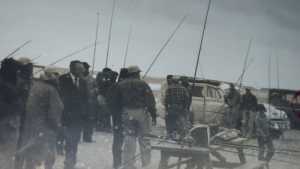The summer heat comes in waves. With hotter temperatures, the fish will shut down and the catch frequency decreases. Fishing early morning predawn or later evening into dark is the best bet for hotter days. The recent cool-off turned the spot and croaker bite back on at the Cape Henlopen Fishing Pier. Flounder fishing there went dry for a while with the heat, then picked back up as things cooled off. There are more consistent flounder around the Inland Bays, the surf, and offshore; however, anglers will find fewer keepers from inland waters. Jigging has been best with Gulp, but drifting minnows abides.
The tautog action is fast for short fish at Indian River Inlet with some keepers. Sheepshead are being caught mostly on sand fleas. It’s easy to go grab a bucket of those at the beach. Christina Puglisi said to me recently while catching tautog at the inlet with Laura Foerster, "We picked a bunch of fresh sand fleas today.” Me: "You mean like off a tree?” She just laughed, “OK, maybe pick wasn't the best word.”
The ladies have been pulling fishing trip trifectas – morning surf fishing, then boat fishing, and then to the inlet to catch tautog to finish off the day.
Use Fishbites and squid for spot and croaker. Change up baits when fish aren't biting on hotter days, and fish in deeper water. Delaware Bay striped bass summer slot season ends Aug. 31; remember it’s only one fish per angler per day.
Offshore anglers are doing well on the usual suspects – the big fish way out front and the sea bass, etc., inshore. Triggers are still a by-catch of sorts. Call your favorite charters for a trip. The offshore flounder has been good fishing.
We are into full-on, end-of-summer fishing – surf, pond, bay, offshore and inshore. Not much changes this time of year except the frequency, and we hope for storms to cool off us and the water.
Now, instead of a long-drawn-out, boring fishing report, I want to tell you about a friend of mine, a living legend.
The Indian River Inlet has a new addition. On the southside facing the inlet is a bench with a sign, titled Catching Waves. The history of Delaware's surf fishing is explained on the sign with a timeline and a QR code to get more info on your smartphone. Next to it is an unassuming bench, just like any normal park bench. Soon it will have a plaque installed, because the two people it honors, Harry and Dottie Aiken, are legends in Delaware's surf-fishing community. I want to thank Delaware State Parks Director Ray Bivens and Rep. Steve Smyk, R-Milton, for making this bench dedication happen. Long story short, because the how is a very long one, they called me and asked, what could we do for Harry Aiken.
I said the best thing would be to name the unnamed surf-fishing crossings (middle and south) at Fenwick Island State Park after Harry and his wife Dottie. They eventually opted for this bench and the sign Catching Waves with a history of Delaware's surf fishing. Thank you, gentlemen, I know you made my friend Harry Aiken, the GOAT of surfcasting, very happy. The story behind the GOAT moniker involves a small, leather-stitched ball and a stadium.
Several years ago, I had the opportunity to sit down with Harry Aiken and talk surf fishing. He will tell you, “I don’t tell fishing stories, I tell truths,” which he does as well as any angler.
Harry has been fishing the Delaware beaches for over 75 years, before parks even existed. I was so excited I was going to talk to the man who knew every nook and cranny of the beaches and Indian River Inlet. What sort of secrets would he divulge to me? What knowledge could I extract from his lifetime of memories to help improve my surf fishing?
Harry is that guy who pulls up on a beach, grabs a rod and starts yanking in fish one after another, usually in front of people who have been fishing all day and catching the skunk. When asked how he did it he would tell them, "You’re fishing in the wrong spot,” and then show them where they went wrong.
One day years ago, I met Harry at his house in Georgetown, sitting around the kitchen table with Bait and Tackle, his two Bombay cats from his shop Ole Salt Bait & Tackle, which he used to operate on New Road in Lewes.
So what is the first thing I ask the grandmaster of the Delaware surf? “Harry,” I said, "tell me about the baseball.” He just smiled.
On June 8, 1968, Harry Aiken cast a baseball out of Yankee Stadium, over right field, in between games during a doubleheader with the Yankees and the Orioles. No one then or now has ever hit a baseball out of Yankee Stadium, but Harry Aiken cast one out of the park, twice, with a surf rod.
I have heard the story from many an angler here, but always wanted to hear the entire tale. I was just dying to hear about the cast that made Harry Aiken a living legend.
In the 1960s, the American Casting Association held casting and accuracy tournaments up and down the East Coast on the town beaches, sponsored by The Ballantine Beer–Garcia Tackle. Harry entered a Rehoboth Beach casting contest in 1964 and found out he could cast very accurately; he came in fourth that day. He went home and set up a practice field in Georgetown, and formed up a team, the County Casters Club, with his wife Dottie Aiken, John Bister, Elaine Bister, Leon Johnson, George Brown, and Jim West.
He was and still is called the GOAT - Greatest Of All Time – by many surf casters up and down the East Coast for his performances during these tournaments. Harry broke his own world record three times. Finally, with a perfect score of 100 out of 100, there was no way to beat it. His wife Dottie held the state championship for a year and was the highest-scoring female caster. In fact, when some of these folks showed up at the tournaments, people already knew who would be placing and winning.
Back then, hitting a 450-foot cast was a long distance, but Harry's longest was 605 feet in a tournament. What kind of gear do you use to get that kind of distance? I mean, look at the gear now compared to those days. I wanted to know.
During the American Casting Association tournaments, Harry met Sal Muley, a promoter for Ballantine Beer-Garcia Tackle, who wanted to take casting tournaments on the road. He was looking for an event to fill in the dead time between and before baseball games, and he came up with the Cast A Ball events.
Teams of surfcasters or baseball players would cast for base hits and Harry would cast cleanup. When Sal showed him Yankee Stadium, he asked Harry if he could cast a home run. Harry, being Harry, said, "No problem; give me a couple of weeks and I will cast it out of the stadium.”
Harry noticed that most balls would just shudder and drop at about 320 feet. He figured out that if he could make the ball spin, it would travel farther; little did he know just how far. A few weeks later, after practicing at home, he was ready. It was not required for a home run, but Harry, being Harry, wanted to go for the fence.
At the very first Cast A Ball demonstration, on his first cast Harry Aiken cranked that surf rod, but his foot slipped and the ball went into the stadium’s second-level 12th row – impressive, but not for Harry.
While the crowd was still bewildered, Harry looked at Sal Mulney and said, "This next one is going somewhere.”
Harry dragged the ball along the ground, got the spin he wanted and put everything he had into that cast. The baseball cleared the stadium and was still climbing when it went over the wall at 344 feet out and 120 feet up. The crowd was now stunned into silence. By the time Harry rounded second base, the stadium of 43,000 people went wild realizing what just happened.
No human has ever sent a ball over the wall at Yankee Stadium, but this guy just did it with a fishing rod. No one ever found the ball, so they don't know how far it actually traveled. Harry will tell you it probably landed in a passing coal car on the train nearby and went even farther.
From that point on, Harry was known as the man who cast a baseball out of Yankee Stadium.
Harry cast two balls out of Yankee Stadium, four out of Shea, two out of Kennedy, and one that hit the rim of the Astrodome. To this day, no one else has ever done this, nor do I believe anyone ever will. Long casting nowadays hits distances over 900 feet, with modified equipment. Harry did it with a basic surf rod from the 1970s. He may have told me about that rod he built, but that is for another day. I think the only cast that would top Harry's feat today is to send a baseball out of a football stadium, the long way. In one day, Harry Aiken opened and closed a chapter in the story of baseball as a surfcasting legend. To me, that’s just my buddy Harry, being Harry.






















































